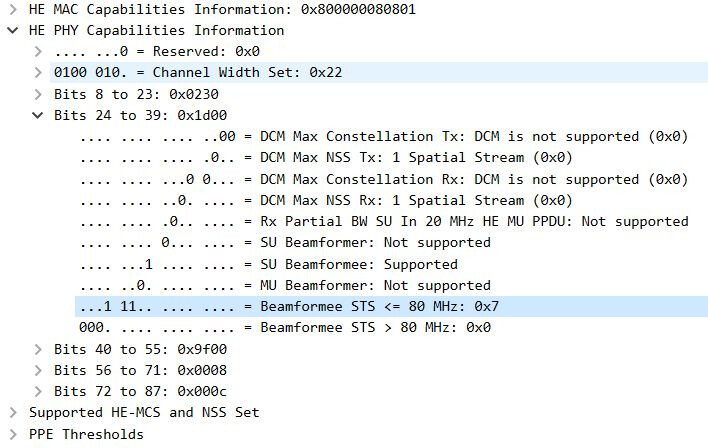Can the downlink TxBf or MU-MIMO performance of 3x3 Wi-Fi AP be identical to that of a 4x4 or 8x8 or 16x16 Wi-Fi AP ?
In order for an AP to do TxBf or MU-MIMO, it requires Channel State Information (CSI) of the wireless multipath channel information between each of the AP’s transmit antennas and the client. If the client is not capable of receiving an NDP sounding frame and providing CSI feedback for all the antennas present at the AP, then the AP cannot exercise its full TxBf/MU-MIMO potential. This crucial client capability is advertised as Beamformee STS field (note that 1 needs to be added to advertised value) in VHT/HE capability IE as shown in picture.
So if the client being tested turns out to support CSI feedback for only 3 beamformer antennas, it does not matter if the AP has 3, 4 or 8 or 16 antennas. Effectively, the AP is forced to behave essentially like a 3x3 AP when transmitting TxBf frames to this client. As a consequence, a 4x4 AP cannot do a downlink MU-MIMO transmission of 2 spatial streams each to two such 2x2 clients (because CSI feedback is not available for all 4 beamformer antennas).
If someone is interested to see excellent MU-MIMO gains with 2x2 clients in 80 MHz bandwidth, you really need an 8x8 AP and clients with Beamformee STS=8 capability.
Most older Wi-Fi clients on the market do not support Beamformee STS=4 or 8, and this hampers the downlink TxBf/MU-MIMO performance between 4x4 or 8x8 APs and such clients. In this context, Wi-Fi 7 has introduced 16x16 as an option and even if someone were to build a 16x16 AP, I wonder if Wi-Fi 7 clients will support Beamformee STS=16 ?
I believe this specific client side limitation along with high cost were some of the reasons that prevented the commercial success of 8x8 Wi-Fi APs. I really wish beamformee STS capability is explicitly mentioned in the technical specs of client devices for full transparency to consumers.
LinkedIn: ![]()
